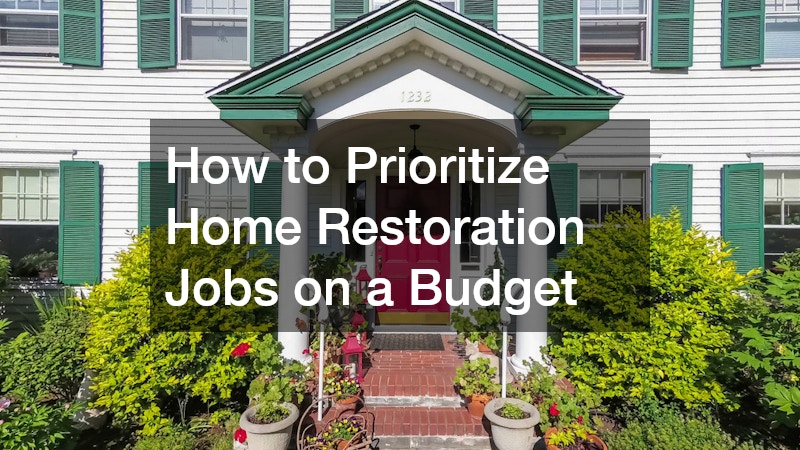Home restoration jobs can feel overwhelming—especially when you’re on a tight budget. Whether your house needs a bathroom renovation, updated plumbing, structural repairs, or just a facelift, it’s easy to get lost in the sheer number of decisions you have to make. But restoring your home doesn’t have to drain your savings or leave you stressed out. The key is learning how to prioritize your projects, tackle what’s most important first, and budget wisely for both immediate needs and future improvements.
This guide is here to help you make smart, informed choices about where to spend your time and money. We’ll walk through everything from identifying urgent repairs to choosing between a DIY approach or hiring professionals like a renovation contractor, local plumbing contractor, electrician, or local electrical contractors. We’ll also touch on what to do when unexpected problems crop up—because in home restoration jobs, they almost always do.
By understanding the essentials, weighing your options, and approaching each step methodically, you can turn a daunting list of home restoration jobs into a manageable, rewarding experience that adds comfort and value to your home without breaking the bank.
How Do I Assess the Home’s Needs?

Conducting a Comprehensive Home Inspection
Before diving into home restoration jobs, start with a detailed inspection of your house. Check the roof for leaks, inspect walls for cracks, test electrical outlets, and look for plumbing issues like slow drains or water damage. Don’t forget to examine the foundation, attic, basement, and crawl spaces—these areas often hide problems like mold, pests, or structural weakness. Some problems may not be visible right away—consider hiring a renovation contractor or local plumbers to help spot hidden issues, especially in older homes.
Take notes and photographs as you go to document everything clearly. This will help you keep track of what needs attention and communicate effectively with professionals later.
If you notice signs of wear in the bathroom, like loose tiles, outdated fixtures, or water spots, a bathroom renovation or even a full bath remodel might climb to the top of your list. Similarly, check for any emergency plumbing services you might need if you discover active leaks or blocked drains.
Determining Urgency vs. Desirability
Not every project needs immediate attention. Distinguish between what’s urgent—like fixing a leaking roof or faulty wiring—and what’s simply desirable, like upgrading to new countertops. Safety-related repairs, such as electrical and plumbing, should always come first. If something threatens the integrity of your home or poses a health risk, prioritize it over purely cosmetic upgrades.
Creating a List of Essential Repairs
Once you’ve completed your inspection, categorize repairs into “urgent,” “needed soon,” and “nice to have.” This list will serve as your roadmap, helping you focus on the most critical home restoration jobs first. Revisiting this list regularly can also help you adjust priorities as your budget or circumstances change.
What Should I Consider Before Starting?
Budget Analysis and Setting Limits
Set a realistic budget before starting any home restoration jobs. Research typical costs for projects like bathroom remodeling, structural repairs, or hiring a local plumbing contractor. Don’t forget to factor in a cushion for surprises, which are almost inevitable.
Assessing DIY Capabilities vs. Professional Help
It’s tempting to save money by doing it all yourself, but some tasks—like electrical or emergency plumbing services—are better left to professionals. Evaluate your skills honestly. Tasks like painting, minor carpentry, or even small bath remodel improvements can often be done yourself, while plumbing and wiring usually require expertise.
Evaluating the ROI of Each Project
Consider which home restoration jobs will add the most value. Bathroom renovation, kitchen updates, and energy-efficient improvements often offer the best return on investment if you’re thinking of selling later.
Which Safety Repairs Should Be Prioritized?
Identifying Immediate Hazards
Safety always comes first. Look for hazards such as exposed wires, gas leaks, or water damage that could lead to mold. Pay close attention to uneven floors, loose railings, or damaged stairs, which can also pose serious risks. Address these issues as soon as possible to keep your home safe for everyone.
Electrical and Plumbing Concerns
Your electrical and plumbing systems are the backbone of a functional home. If you notice flickering lights, tripping breakers, or strange smells, call an electrician or local electrical contractors. Similarly, if pipes burst or toilets overflow, you’ll need local plumbers or even emergency plumbing services to fix the problem quickly. Regularly testing smoke and carbon monoxide detectors is another critical step.
Long-Term Environmental Improvements
Beyond immediate hazards, look at long-term environmental factors such as indoor air quality. Sealing drafts, replacing old insulation, and fixing leaks not only improve comfort but also prevent future issues. Investing in proper ventilation can also help reduce allergens and humidity levels over time.
How Do I Manage Aesthetic Upgrades?

Prioritizing High-Traffic Areas
When money is tight, focus aesthetic upgrades on high-traffic areas that make the biggest impact, like the kitchen, living room, and bathrooms. A simple bath remodel or bathroom renovation can transform the feel of your home without consuming your entire budget.
Selecting Affordable Materials
You don’t have to choose the most expensive materials to achieve a beautiful result. Laminate, engineered wood, and budget-friendly tile can mimic high-end looks at a fraction of the price.
DIY Aesthetic Improvements
Paint, new hardware, updated light fixtures, and simple décor changes are cost-effective ways to refresh your home. Many of these upgrades are beginner-friendly and make a noticeable difference.
What’s the Best Approach for Structural Problems?
Recognizing Structural Damage
Structural issues like cracks in the foundation, sagging floors, or bowed walls require prompt attention. These aren’t just cosmetic—they can compromise the entire integrity of your home. Look for doors or windows that no longer close properly, gaps between walls and ceilings, or sloping floors as additional warning signs.
Prioritizing Load-Bearing Repairs
Always tackle load-bearing repairs first to ensure your home remains safe. If you’re unsure, consult a renovation contractor for guidance. They can identify which components are critical and help you plan repairs efficiently.
Cost-Effective Solutions for Structural Repairs
Some structural repairs can be managed affordably by addressing root causes early. Preventative maintenance and timely fixes are often much cheaper than waiting for problems to escalate. Consider reinforcing vulnerable areas with additional supports or sealing small foundation cracks before they worsen and become more expensive to repair.
How Can Energy Efficiency Be Enhanced?
The Importance of Insulation
Proper insulation can save you money on heating and cooling while making your home more comfortable. This is one of the more affordable home restoration jobs with a big payoff. Insulation helps regulate indoor temperatures, reducing the workload on your HVAC system and lowering energy bills year-round. When upgrading insulation, pay special attention to attics, walls, basements, and crawl spaces, as these areas tend to lose the most heat. Different types of insulation—like fiberglass, spray foam, or cellulose—offer varying levels of effectiveness and cost, so choose the option that best fits your home and budget.
Upgrading Windows and Doors
Replacing drafty windows and doors can prevent energy loss and improve your home’s value. Even simple weather-stripping can help if full replacements aren’t in the budget yet.
Implementing Smart Home Technologies
Smart thermostats, energy-efficient lighting, and programmable systems help manage energy use. These upgrades can be incorporated gradually and pay off over time. For example, smart thermostats learn your schedule and adjust temperatures accordingly, saving energy when you’re away. LED lighting uses less electricity and lasts longer than traditional bulbs. Smart power strips and sensors can reduce phantom energy use from idle electronics. Together, these technologies create a more responsive and efficient home environment.
What Are the Best Financing Options?

Assessing Loans and Credit Lines
If you can’t pay for everything out of pocket, explore financing options like home equity loans, personal loans, or credit cards designed for home improvements. Compare interest rates and terms carefully.
Government Grants and Incentives
Some home restoration jobs, like energy-efficient upgrades, may qualify for government grants or rebates. Research local programs to help offset costs, including tax credits for installing solar panels, efficient windows, or insulation. These incentives can significantly reduce upfront expenses and make green upgrades more accessible.
Budgeting for the Long Term
Plan your finances not just for the current project but also for future maintenance and improvements. A steady, sustainable approach prevents financial strain and ensures you’re prepared for unexpected repairs. Setting aside a dedicated fund for home restoration jobs helps keep your projects on track without derailing your budget.
How to Deal With Unexpected Issues?
Creating a Contingency Fund
Set aside at least 10–15% of your budget for unexpected problems. From discovering water damage to needing emergency plumbing services, surprises are inevitable in home restoration jobs.
Dealing With Code Violations
If your home has code violations—often uncovered during inspections—address these immediately. Professionals like local plumbers, electricians, or a renovation contractor can help bring your house up to standard.
Adjusting Project Plans
Stay flexible. Sometimes you may need to pause one project to focus on a more pressing issue. Being adaptable will help you keep your budget and sanity intact.
How to Maintain Improvements Over Time?
Regular Maintenance Routines
Protect your investment by keeping up with maintenance. Clean gutters, service HVAC systems, and inspect plumbing and electrical systems regularly.
Seasonal Adjustment and Upkeep
Adjust maintenance tasks according to the season—seal drafts before winter, clean out drains before heavy rain, and check wiring after storms.
Involving the Household in Upkeep
Get everyone in the house involved in basic upkeep. Teaching family members how to recognize small problems can help prevent larger, costlier repairs down the line.
When Is It Time to Call a Professional?

Recognizing the Limits of DIY
Knowing when to stop and call in a pro is crucial. Electrical work, plumbing problems, and structural repairs are often too risky for DIY. Attempting these tasks without the right tools and expertise can lead to injury, costly damage, or even legal issues if building codes aren’t met. It’s better to invest in a qualified expert than to risk making mistakes that could double your expenses later.
Choosing the Right Professional Services
Take your time vetting professionals. Look for licensed, insured, and experienced contractors. Whether you’re hiring a local plumbing contractor, electrician, or renovation contractor, check reviews and get multiple quotes. Don’t hesitate to ask for references and examples of past work to ensure they’re a good fit for your project.
Managing Professional Project Timelines
Once you hire professionals, keep communication clear and expectations realistic. Work with them to set achievable timelines and stay involved to ensure things stay on track. Regular check-ins, written agreements, and flexibility when small delays occur will help keep the project moving smoothly and reduce stress throughout the process.
Conclusion
Tackling home restoration jobs on a budget can seem intimidating, but it’s entirely doable with the right mindset and planning. The key is understanding your home’s most urgent needs and creating a clear plan to address them while staying within your financial limits. From prioritizing safety-related repairs like electrical and plumbing to finding affordable ways to enhance your home’s aesthetic and energy efficiency, every choice you make brings you closer to a safer, more comfortable, and more beautiful space.
Remember to lean on professionals—like a trusted renovation contractor, local plumbing contractor, electrician, or local electrical contractors—when the job demands expertise. They can save you time, stress, and costly mistakes, especially when it comes to bathroom renovation, bath remodel, bathroom remodeling, or emergency plumbing services.
Finally, keep in mind that home restoration jobs aren’t a one-time event but an ongoing process. By staying proactive with maintenance and budgeting for future improvements, you’ll protect your investment and continue to enjoy the rewards of your hard work. Even when surprises arise, you’ll be prepared to handle them gracefully and move forward confidently.
When done thoughtfully, home restoration jobs don’t just improve your house—they enhance your quality of life. Take it step by step, stay flexible, and you’ll find that transforming your home within your budget is not just possible but deeply satisfying.
